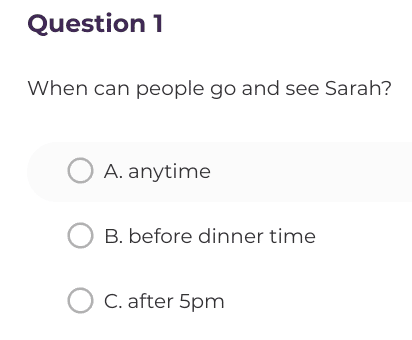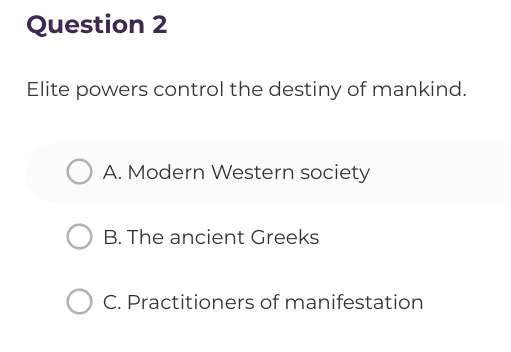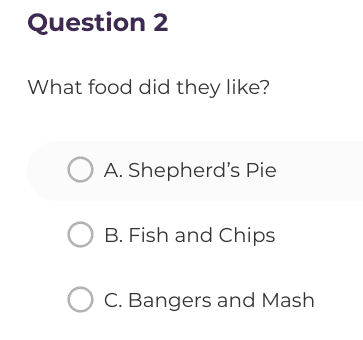So, you’ve decided to take the IELTS listening test! Congratulations! You should be prepared for all parts of the test.
This article focuses on the IELTS Listening section. You’ll find out about:
- The test itself and what you need to do.
- Common mistakes that people make when taking the test.
- Study techniques and use of IELTS listening practice tests.
- How GlobalExam can help you.
You could also find online articles with exercises on the IELTS Academic Writing, the IELTS Reading Test and sample questions for the IELTS Speaking test.
IELTS Academic And General Exams: What Listening Skills Are Evaluated?
The IELTS listening section, like other parts of the sections, is designed to evaluate people’s English level from beginners all the way through to C2 level. As it’s designed to measure everyone, it’s normal that there are parts of the test that you don’t understand, especially later on in the test. Don’t worry – simply answer what you can even If you’re not sure. You don’t get negative points for a wrong answer.
The test is made up of 40 questions, split into 4 sections. The test gets progressively harder as you progress from section to section, so Part 1 is the easiest and Part 4 is the most difficult. Remember: You’ll only hear the listening once, so you need to concentrate!
What Abilities Does the Listening Section Measure?
The Listening section measures your ability to:
- Understand basic conversations and everyday social context
- Focus and note precise information (prices, phone numbers, names…)
- Understand a discussion between several speakers set in an everyday situation
- Comprehend a longer monologue on educational or training context
Your score for the Listening section will improve if you are more familiar with the test and the different sections. It is also important to see the different types of question papers and understand where it’s easy to make a mistake.
IELTS Listening Practice Tests With Corrections
By doing IELTS listening practice and working through the corrections, your score (and your English!) will improve. The test itself lasts 30 minutes and then you have 10 minutes to transfer your answer to the answer sheet. Use this time to check your answers carefully!
Check your spelling and that you have answered the questions in the correct way.
For example, if the question is (student discussing an assignment):
How long is her break? ______________ minutes
You write “40 minutes” – unfortunately you’re wrong! Your answers need to be grammatically correct as well as accurate. So, the correct answer is “15” or “fifteen”. This is the type of thing you can check in the 10 minutes when you’re transferring your answers. Similarly, read the questions carefully. If the question says: “Using one number and / or two words”, you cannot write three words. It seems confusing, but with a bit of practice, it gets much easier!
Let’s have a closer look at the first part of the test.
IELTS Listening Practice Test Part 1: Short Conversation
The first part of the IELTS Listening test is a brief conversation between two people. When the test starts, you’ll be given some time to read the questions before the listening begins. During the first listening section there may be a short pause to let you read the next set of questions.
A favourite IELTS question in Part 1 is for a phone number or a name. Make sure you’re comfortable with numbers and the alphabet.This part is not easy to get points. Often when they’re reading the name or the number, the speaker will realise it’s wrong and go back and change their answer, so be careful!

In the example above you have the choice of three answers. The test is evaluating firstly whether you can tell the difference between one hundred and two hundred and secondly between twenty, thirty and forty. If you’re not sure you can hear the difference, you can click and hold on the progress bar and rewind the listening. When you’re training, you should do this until you are sure you’ve heard the correct answer.

You will find explanations about correct and incorrect answers. When you finish, remember to read the transcript to check your answers and note down any new vocabulary!
IELTS Listening Sample Test Part 2: Monologue
In the second part of the Listening section, you’ll hear a monologue – often it’s someone giving information about concert tickets, or visiting a park for example. The type of information you’ll be given includes times and places, prices, things to remember and so on. Although the speaker may talk slightly slower than in Part 1, they will pause less. You should concentrate the most. It could become more challenging for test takers with a lower level of English.
Let’s have a look at the following example:

If you’re reading this and thinking: “Wow! That’s difficult!” – be warned! This is about a quarter of the actual complete transcript!
IELTS Listening Part 2 lasts between 5 and 7 minutes and is one person speaking, so you really need to focus. Again, use the time given to read the questions carefully and try to pick out the key information you need to listen for.
For example, with question 1:

The key information here is “when” and “see Sarah”. As with the Reading, you don’t need to understand every word, but you do need to find the key information as quickly as possible! It’s why using IELTS listening sample tests is so useful!
IELTS Listening Practice Test Part 3: Long Conversation
IELTS Listening Part 3 is another conversation, but this time is longer and the subject will be more complicated. A typical example would be two students discussing a project they need to do – they’ll decide who needs to do what, when the deadline is, what the next step is and so on.
Typically the grammar and the vocabulary in Part 3 is more difficult than in Parts 1 and 2.
Use the time given to read the questions carefully and pick out the key information you need to listen out for. If there is a word you don’t understand in a question, don’t panic – it may just be there as a distraction!
A good example of this is the following:

The three dishes are very common in the UK, but it’s possible you aren’t familiar with any of them. It doesn’t matter – you only need to listen for which one they like. Very often when there is something like this in the listening, the speaker will explain what it is at some point. Perhaps the other speaker will say: “Bangers and Mash? What’s that?”
The more practice papers you do, the more you’ll hear how the questions are structured and used. The more comfortable you feel with the style of questions, the better you’ll understand!
IELTS Listening Sample Test Part 4: Lecture
Part 4 of the Listening Section is easily the most difficult. Not only is it a long monologue, but it’s speaking about an academic subject! In addition to this, you’ve already been concentrating for the last twenty minutes on Parts 1, 2 and 3!
One of the best things you can do to train for Part 4 is to expand your knowledge in English as much as possible. Read and listen to many different subjects – the environment, restaurant reviews, articles on dinosaurs… Anything will be good training! A good tool to help you is the Social and/or the World & Environment section on GlobalExam’s vocabulary training documents. Subjects covered include money, the media, countryside and farming and these are all examples of the types of topic that could be covered in Part 4.
The more vocabulary you know, the easier you’ll understand what the speaker is saying!
Here’s an example question from Part 4:

Simply from the question, you can see it’s far more complicated than Parts 1 and 2!
Part 4 is really designed to separate B2 levels from C1 and C2. The level of vocabulary and grammar is much higher, and a typical A2 level will find Part 4 very difficult to understand. This doesn’t mean it’s impossible but it gives you an idea of how much work you’ll need to do if you’re aiming for a B2 result!
Start Training For The IELTS Listening Practice Test Online
That’s where GlobalExam can really help test takers. Our site is designed specifically to target test training where people set their own goals. You can improve your level globally and you specifically train for the test of your choice. We cover 27 tests in 5 different languages! You have access to numerous IELTS practice exercises with corrections and advice. The corrections are explained in order to learn from your mistakes and be best prepared for the test.
There are also 5 sample tests which you can take under test conditions! This means you can take a full test, train for a month and take another test to track your progress. Nothing is more motivating than seeing your score increase! We also provide statistics so that you can see where you need to work more – perhaps your Reading score is great, but your Listening score is quite low. Following your statistics ensures that you’re prepared for every section of the test. Practice also with mock tests and exercises for the IELTS exam.
Have a look at what GlobalExam has to offer – let us help you get the band score you’re after!



